CH3NO2
Senior Member
  
Joined: March 2017
Posts: 455 
|
Post by CH3NO2 on Sept 7, 2017 8:37:54 GMT -5
Hi Anders,
When you sized the water injection nozzle did you target a particular water/air mass flow ratio?
Tony
|
|
|
|
Post by Johansson on Sept 17, 2017 15:40:36 GMT -5
Hi Tony, Not really, I just ordered the largest spray nozzle I could find for reasonable money.  |
|
|
|
Post by Johansson on Sept 17, 2017 15:50:48 GMT -5
Tonight I undressed the bike to remove the engine and check it for wear. 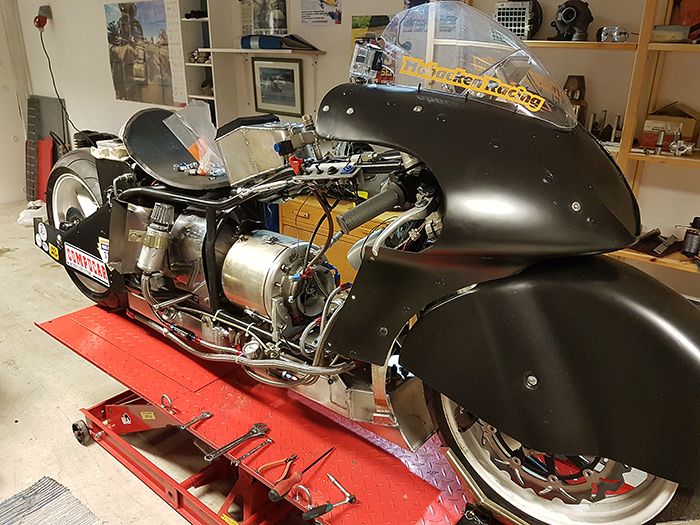 I assumed the gas producer turbine would look like the Fukushima reactor core but to my surprise I couldn´t find any evidence of overheating, mostly it was soot that seems to have come from oil leaking past the rear seal. 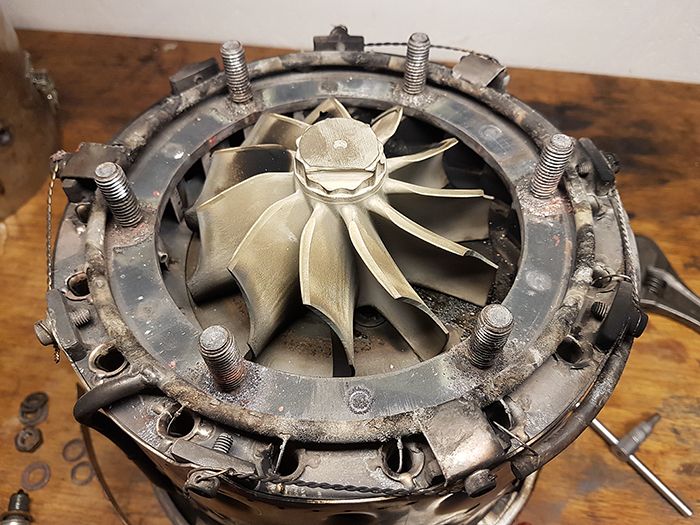 Sharp turbine inducer tips, not what I expected to find!  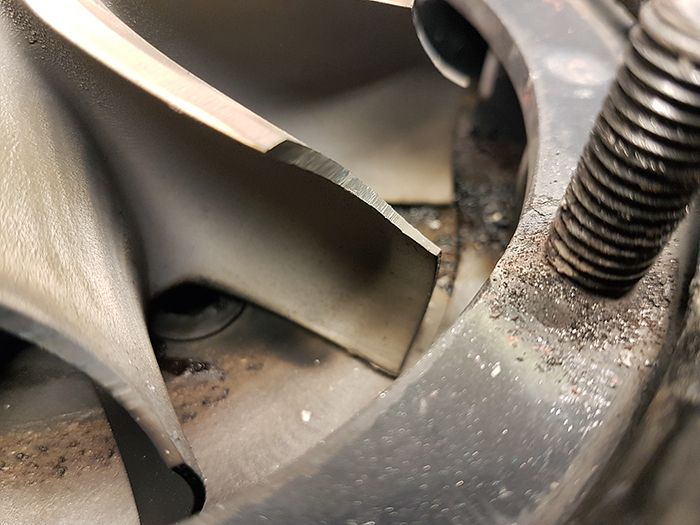 The C20 power turbine was in a sorrier state though, one large crack and a couple of hairline cracks through the outer rim. Wear marks on the radial seals tells me that this must have happened while the bike was running and not while cooling down after the last run. No signs of cracks in the hub section which is a relief, lets just say that the turbine wheel stress relieved itself at 25.000rpm...  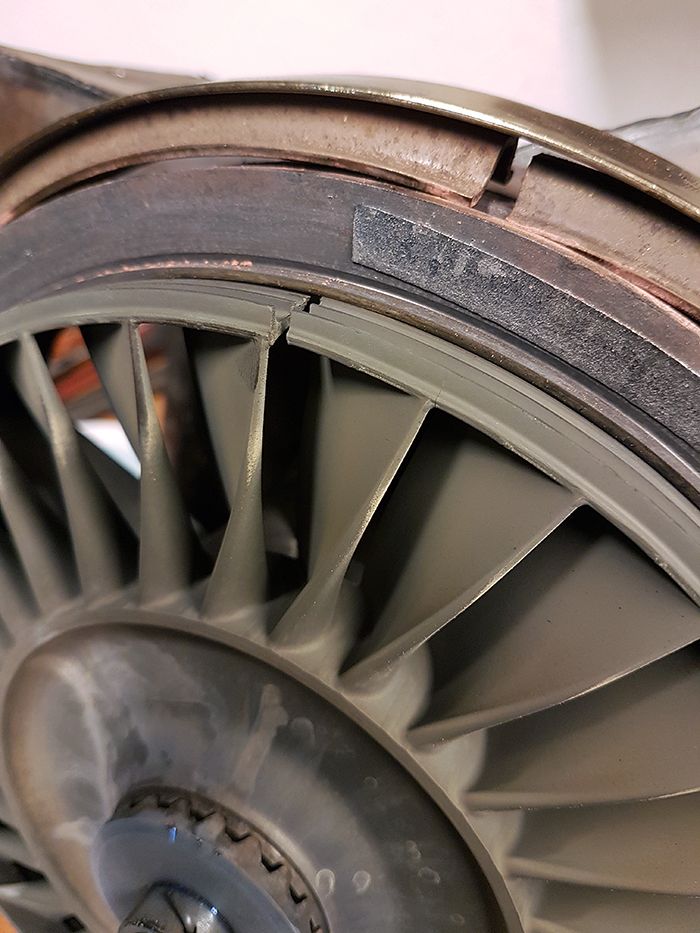 This is a good reminder to keep the temps in check, the new engine seems to be running at much more reasonable temperatures so I´ll just decide to not let the interstage temps go much past 750°C and this shouldn´t happen again. 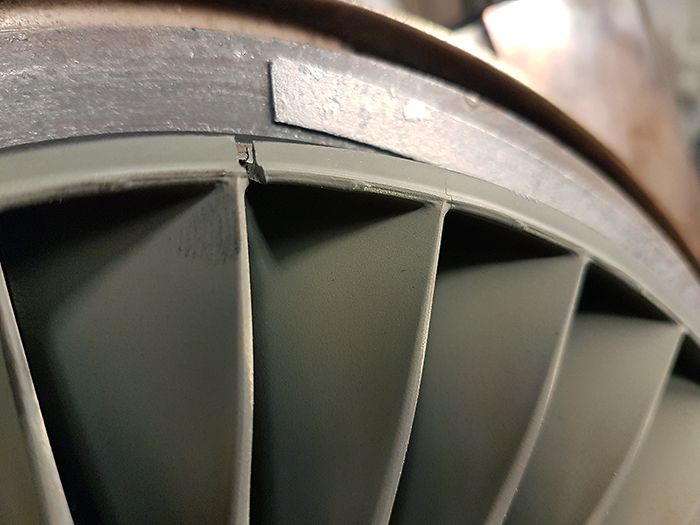 I have a fresh 4th stage wheel on the shelf but am in need of a spare one so in case anyone has one they want to part with I am interested as long as the price is right. Cheers! /Anders |
|
|
|
Post by Johansson on Sept 17, 2017 16:16:33 GMT -5
I wonder if the heat downstream the JU-01 could have been caused by a scavenge pump failure? This would explain why the gas producer turbine looks ok while the power turbine wheel was running while glowing hot.
It has happened to me once before, the old scavenge pump started losing power for some reason and this caused oil to start coming out through the turbine shaft seal and slowly filling up the engine. The soot marks indicate that there has been oil leaking from the turbine seal, and if this oil caught fire in the interstage duct while running it would have heated up the C20 wheel really fast.
/Anders
|
|
|
|
Post by racket on Sept 17, 2017 17:54:24 GMT -5
Hi Anders
Gas producer turbine looks "normal" , so we can be reasonably confident it wasn't being subjected to 1250 C for the T I Ts , so your interstage "reheat" is looking a likely culprit , but is it fuel , oil , or a combination .
You mentioned before that you're only able to get a ~2.4 Bar P2 before running out of fuel pressure , do you have any flow measurements for your system to check if its fuel pump or that a proportion of the fuel isn't being burnt in the flametube but possibly downstream .
As the gas velocity into, through and out of the wheel is too high for combustion to take place , it would need a "quiet spot" to provide a "flame holder" , this could be where the gases detach from the ID of the interstage outer duct work due to the relatively steep expansion angle required to go from exducer dia to freepower diameter over a short axial distance , if the thermocouple was positioned near such a spot it could account for the high temps ...............are there any witness marks inside the interstage duct that might indicate something like this happening ??
If we assume your gas producer is running at normal temps and you have a TOT of say 700 C then theres going to be a need for a fair bit of "fuel??" to get those temps up to the ~1,100 C being measured, we'd be needing roughly half as much as whats going into the flametube to get our normal operating temps ...............we'd be looking at possibly 1 lpm of "fuel" .............how is the "fuel level" in your oil tank??
LOL, yep , the freepower laby seal looks a tad worse for wear , they "crack" the seal in several places during manufacture on some wheels to relieve those stresses..............Andrew had similar experience with the 3rd stage wheel in the TV84 bike ..................it mightn't hurt to think about slitting the laby seal on your replacement, possibly every 5 or 6 blades to provide stress relief whilst still maintaining rigidity for the blades .
Cheers
John
|
|
|
|
Post by smithy1 on Sept 17, 2017 20:45:04 GMT -5
Anders,
I'm pretty sure have C20B 3rd & 4th stage wheels at home...let me check at home first before I commit to sending you one..!
And yes, the very first 3rd stage wheels were split at the factory to help avoid cracking issues, then about mid-way through the engine's life they made them solid but had hub cracking issues, now they are all split again...but in a different way, the 4th stage wheels never were split, although there's a new revision 4th stage wheel being released very soon, so we'll soon find out.
If split at the factory, the 3rd stage wheels must be split on the outer labby seal all the way through the outer ring between the blades and not overlapping to the end of a blade, if not the result can be a bit ordinary..!
Also, there's an N2 rpm range where Rolls-Royce warn against as it will produce harmonic vibrations possibly causing hub and blade fatigue cracking etc...Do you know rpm you are running your N2 system Anders??
Rolls-Royce have a CEB (Commercial Engine Bulletin #1400) which states, (depending on the 3rd & 4th wheel part numbers), the "N2 RPM Avoidance Range" of 71%-88% N2 where 33,290rpm is 100%...so steady state rpm's from 23,636 to 29,040 should essentially be avoided, transitions through this rpm range should be as short as practical.
Basically the wheels have less chance of issues if run at their maximum designed rpm of ~33k rpm.
Smithy.
|
|
|
|
Post by Johansson on Sept 18, 2017 4:54:27 GMT -5
Hi Anders Gas producer turbine looks "normal" , so we can be reasonably confident it wasn't being subjected to 1250 C for the T I Ts , so your interstage "reheat" is looking a likely culprit , but is it fuel , oil , or a combination . You mentioned before that you're only able to get a ~2.4 Bar P2 before running out of fuel pressure , do you have any flow measurements for your system to check if its fuel pump or that a proportion of the fuel isn't being burnt in the flametube but possibly downstream . As the gas velocity into, through and out of the wheel is too high for combustion to take place , it would need a "quiet spot" to provide a "flame holder" , this could be where the gases detach from the ID of the interstage outer duct work due to the relatively steep expansion angle required to go from exducer dia to freepower diameter over a short axial distance , if the thermocouple was positioned near such a spot it could account for the high temps ...............are there any witness marks inside the interstage duct that might indicate something like this happening ?? If we assume your gas producer is running at normal temps and you have a TOT of say 700 C then theres going to be a need for a fair bit of "fuel??" to get those temps up to the ~1,100 C being measured, we'd be needing roughly half as much as whats going into the flametube to get our normal operating temps ...............we'd be looking at possibly 1 lpm of "fuel" .............how is the "fuel level" in your oil tank?? LOL, yep , the freepower laby seal looks a tad worse for wear , they "crack" the seal in several places during manufacture on some wheels to relieve those stresses..............Andrew had similar experience with the 3rd stage wheel in the TV84 bike ..................it mightn't hurt to think about slitting the laby seal on your replacement, possibly every 5 or 6 blades to provide stress relief whilst still maintaining rigidity for the blades . Cheers John Hi John, I will do a closer check of the interstage section tonight and take some pics of the internals, I won´t do any more thorough investigations though since the engine is bound for retirement and I want to get busy on JU-02 as soon as possible. One thing that I will improve before I fit JU-02 to the bike is to make the oil return line much larger in area, it might be causing back pressure for the scavenge pump and wear it out. Hmm, cutting the turbine wheel feels like risky business although I understand the idea behind it. I hope that the new one will survive anyway if the temps are kept in check. Anders, I'm pretty sure have C20B 3rd & 4th stage wheels at home...let me check at home first before I commit to sending you one..! And yes, the very first 3rd stage wheels were split at the factory to help avoid cracking issues, then about mid-way through the engine's life they made them solid but had hub cracking issues, now they are all split again...but in a different way, the 4th stage wheels never were split, although there's a new revision 4th stage wheel being released very soon, so we'll soon find out. If split at the factory, the 3rd stage wheels must be split on the outer labby seal all the way through the outer ring between the blades and not overlapping to the end of a blade, if not the result can be a bit ordinary..! Also, there's an N2 rpm range where Rolls-Royce warn against as it will produce harmonic vibrations possibly causing hub and blade fatigue cracking etc...Do you know rpm you are running your N2 system Anders?? Rolls-Royce have a CEB (Commercial Engine Bulletin #1400) which states, (depending on the 3rd & 4th wheel part numbers), the "N2 RPM Avoidance Range" of 71%-88% N2 where 33,290rpm is 100%...so steady state rpm's from 23,636 to 29,040 should essentially be avoided, transitions through this rpm range should be as short as practical. Basically the wheels have less chance of issues if run at their maximum designed rpm of ~33k rpm. Smithy. Hi Smithy, I´m very interested in purchasing a wheel in case you have one for sale! With the bike geared for 340km/h I have been running in that RPM zone for almost half a mile, I have deliberately geared the bike tall to keep the gearbox revs down but perhaps it is better to just have a 10km/h margin to the expected top speed? I´ll gain some HP as well if I increase the freepower RPM so all for the better as long as the gearbox can cope with it. |
|
nersut
Veteran Member
  
Joined: September 2012
Posts: 223
|
Post by nersut on Sept 18, 2017 7:55:27 GMT -5
Hi Anders I have a 3rd stage turbine wheel up for sale on eBay (262946065895), but you can have it for free if you could pay for the shipping  Cheers Erik |
|
|
|
Post by Johansson on Sept 18, 2017 10:08:35 GMT -5
Hi Anders I have a 3rd stage turbine wheel up for sale on eBay (262946065895), but you can have it for free if you could pay for the shipping  Cheers Erik Thanks a lot for the kind offer Erik, but a 3rd stage wheel is no good for my purposes. I need a 4th stage. |
|
nersut
Veteran Member
  
Joined: September 2012
Posts: 223
|
Post by nersut on Sept 18, 2017 12:17:00 GMT -5
Ah okay  Hi Anders I have a 3rd stage turbine wheel up for sale on eBay (262946065895), but you can have it for free if you could pay for the shipping  Cheers Erik Thanks a lot for the kind offer Erik, but a 3rd stage wheel is no good for my purposes. I need a 4th stage. |
|
|
|
Post by Johansson on Sept 18, 2017 14:11:24 GMT -5
Here are some more detailed pics of the freepower NGV, it was difficult to take good pictures but I managed to Photoshop the pics so they sort of represent the truth. 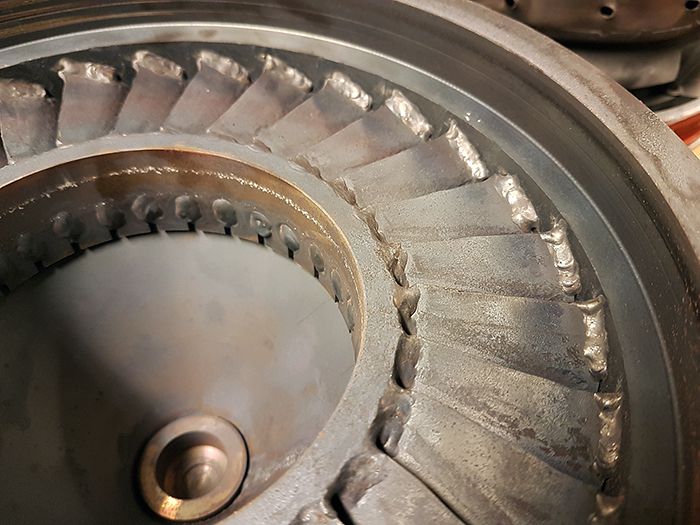 The stainless guide vanes show signs of having been really hot but that isn´t very surprising given how they glowed during the last run. The leading edges aren´t melted and the pittings in the first pics are from the air grinder when I opened up the flow area a couple of years ago. 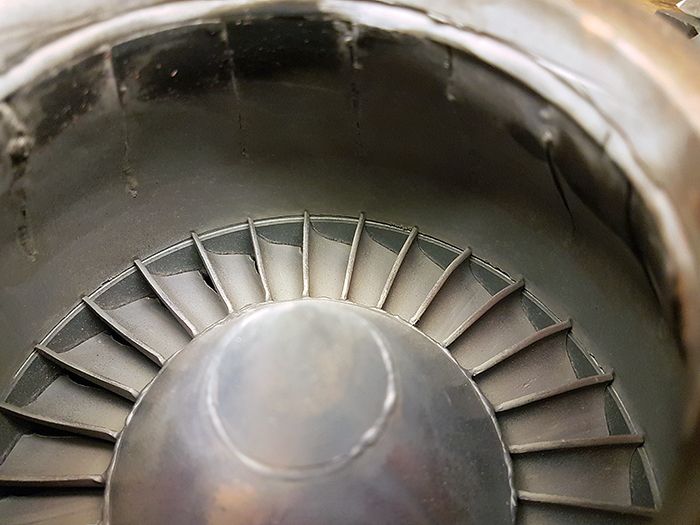 Cheers! /Anders |
|
|
|
Post by smithy1 on Sept 18, 2017 15:30:11 GMT -5
Hi Anders,
I do indeed have a C20B 4th stage wheel at home...it's in pretty good condition too....Also have two 3rd stage wheels, one is the newer split outer ring type...the other is an earlier solid outer ring type, both in good condition....all just cycle expired for aircraft use.
I'll bring it into work over the next couple of days and take some pics for you....should be fine for your use. Then we'll organize to get it to you..!
Cheers,
Smithy.
|
|
|
|
Post by Johansson on Sept 18, 2017 15:39:47 GMT -5
Hi Anders, I do indeed have a C20B 4th stage wheel at home...it's in pretty good condition too....Also have two 3rd stage wheels, one is the newer split outer ring type...the other is an earlier solid outer ring type, both in good condition....all just cycle expired for aircraft use. I'll bring it into work over the next couple of days and take some pics for you....should be fine for your use. Then we'll organize to get it to you..! Cheers, Smithy. Wohoo!  No hurry at all, I´ll be bench running JU-02 all winter so I won´t be needing a spare wheel before next summer if all goes as planned. Well, I hope I won´t ever be needing it but you get my point.  /Anders |
|
|
|
Post by racket on Sept 18, 2017 20:19:26 GMT -5
Hi Anders
Please don't be too hasty to pass up the opportunity to understand what might have been happening , there could be some large horsepower potentials to be had if we can "control" the situation .
Your 306 kph greatly exceeded my most optimistic "real world" outcomes for the JU-01 engine , it doesn't hurt to dream of fantastic horsepowers etc , but as you know , turbine engines are only maths and physics and we can't change the "Laws" , LOL...........and it was starting to look like you might of, so I thought I'd better start looking at "numbers" .
Lets assume you had a 1.6 :1 PR in the interstage and the temperature was at the gauge ~1100 C - 1370 K, compared to say ~730 C - 1000 K .
Temperature drops across the freepower stage would be ~135 C degrees for the high temp and ~100 C degrees for the "normal" temp .............that equates to an ~35% difference in horsepower.
Mass flow should have been restricted a bit due to "thermal?? choking" caused by the low gas density and increased volume trying to get through a limited NGV and wheel flow area , it is partially offset by the greater gas velocities from the greater temp drops , but the "square root" in the formula holds things back .
Now , the C20 4th stage wheel is a relatively low speed turbine wheel with tip speeds of only ~1,200 ft/sec , partly necessitated by the weight of the tip laby seal but also because of the available gas velocities produced in a 2 stage freepower ............lower gas speeds should produce less losses, so understandable to use them if possible .
The C20 wheel is undoubtedly made from pretty decent material which can most likely cope with high temps if the scenario is "controlled" ......................LOL, just letting my mind wander a bit here for possible development upgrades in the future ;-)
Some years ago Andrew and I were considering removal of the laby seal and shortening the blades by ~10mm to better match the TV94 comp wheel flow .
Could you please measure up the current flow area thru your NGV and turb wheel outlet so that we have some sizes to go with your measured temperature and performance,......... it'll be a datum for future work with the JU-02 , no point letting such valuable info be lost .
Cheers
John
|
|
|
|
Post by Johansson on Sept 19, 2017 8:25:28 GMT -5
Hi John, With JU-01 taken out of the bike I have all the time in the world to investigate the issue while continuing to develop the JU-02 engine, so if you guide me through it and tell me what to measure it is a go.  How much can we rely on the temp readings I´ve been getting when doing performace calculations? I mean, with 1000+C interstage temps the engine would have melted long ago, and despite changing both temp sensors and their locations I have always been getting strange temp readings. I´ll measure the flow areas of the C20 wheel and NGV and get back to you with the numbers. Cheers! /Anders |
|